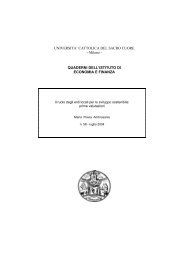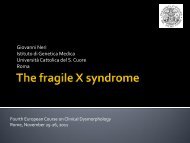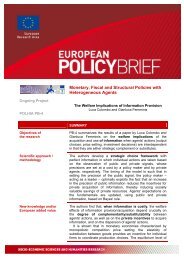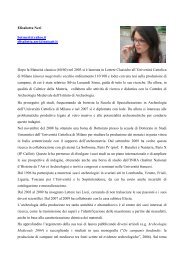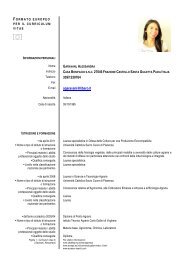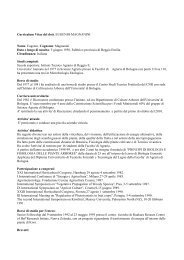UNIVERSITA' CATTOLICA DEL SACRO CUORE - Milano - Istituti
UNIVERSITA' CATTOLICA DEL SACRO CUORE - Milano - Istituti
UNIVERSITA' CATTOLICA DEL SACRO CUORE - Milano - Istituti
Create successful ePaper yourself
Turn your PDF publications into a flip-book with our unique Google optimized e-Paper software.
At the opposite, other prominent authors are in favor of structural separation,<br />
arguing it could overcome the competitive problems Tlc liberalized markets have<br />
been experiencing so far, giving society a substantial benefit, net of its costs 55 .<br />
Several different industrial structures fall under the general category of structural<br />
separation 56 . The rest of the paper will focus essentially on ownership separation<br />
and on operational separation, although other forms of structural separation have<br />
interesting features (and are thus briefly introduced); by way of example, one<br />
could mention club ownership and separation into reciprocal parts 57 .<br />
Ownership separation represents the extreme form of structural separation,<br />
requiring line-of-business restraints or other controls to prevent re-integration. It<br />
eliminates the incentive to discriminate against downstream competitors. Apart<br />
from price or quality discrimination, it also eliminates cross subsidisation and thus<br />
margin squeeze. Hence, separation lightens (but does not remove completely) the<br />
need for active regulation; this is a major advantage, since the preceding section<br />
demonstrated that in real life regulation is often costly and only partially effective.<br />
Further, by reducing incentives to withhold information and to delay<br />
implementation, it is likely to improve the quality and effectiveness of remaining<br />
regulation. On the other hand, scope economies are completely lost: this may<br />
constitute a huge drawback. Further, one-shot costs from separation may offset<br />
competitive benefits.<br />
Joint (or Club) ownership of the non-competitive component by downstream<br />
competitors also eliminates incentive to discrimination, while preserving (at least<br />
partly) pressures for the upstream activity to operate efficiently and scope<br />
economies. However, this approach is likely to result inconsistent with the goal of<br />
competition promotion, since it provides downstream firms with a powerful<br />
means to deter new entry and to facilitate collusion.<br />
Operational separation is a lighter form of structural approach, since it implies the<br />
control of the non-competitive activity by an entity which is independent by the<br />
owner. This is often considered as an hybrid approach, somewhere in between<br />
structural separation and (behavioural) access regulation. When the controller of<br />
the non-competitive activity represents downstream firms, operational separation<br />
approximates club ownership; on the contrary, when the controlling entity<br />
represents the regulator, it comes close to access regulation. The main advantage<br />
of this approach is the fact that, provided the independent entity has full control of<br />
davanti alla public policy non ci sono scorciatoie ma un’attività onesta, forse poco eccitante ma in<br />
pratica utilissima alla collettività, di regolazione e di intervento antitrust. Il brivido, se ci sarà,<br />
verrà ancora una volta dalla tecnologia”.<br />
55 It suffices to remember the position expressed by the Agcm President Giuseppe Tesauro in<br />
several occasion, such as in AGCM [2002]: “In particolare, l’Autorità ritiene che da un punto di<br />
vista concorrenziale, la soluzione più idonea a garantire il rispetto del principio di parità tra i<br />
diversi operatori sia quella di una separazione strutturale proprietaria, o comunque almeno<br />
societaria, delle attività di gestione dei servizi di rete da quelle di fornitura di servizi finali<br />
dell’operatore verticalmente integrato” Along the same line of reasoning, AGCM [2004].<br />
56 For the sake of simplicity, in the following of the paper the upstream activity is considered as<br />
the non-competitive component and the downstream activity as the competitive one.<br />
57 The classification adopted here draws extensively on OECD [2001] p. 6-14.<br />
17




